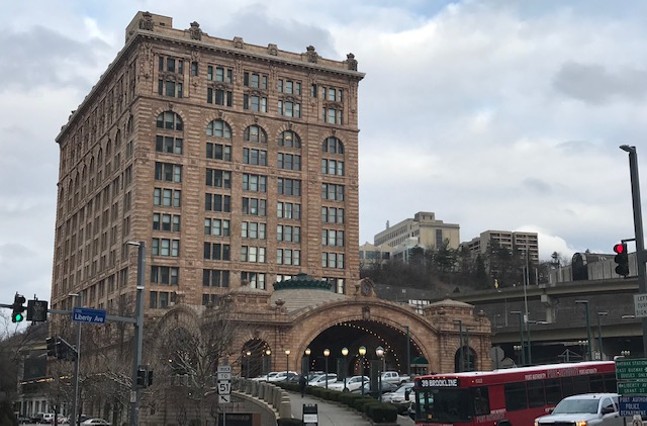Pennsylvanians want more trains. The Amtrak Pennsylvanian line runs only once a day from Pittsburgh through Harrisburg to Philadelphia, New Jersey and New York. Adding more service has been proposed for years, with towns like Johnstown, Pittsburgh, Huntingdon, and Lewistown begging for another train.
But results from feasibility studies looking at adding passenger rail service have yet to emerge. A study on adding more service from Pittsburgh to Altoona is allegedly in process, but that extra service’s potential future funding is currently in dire straits. And another study looking at adding service from Pittsburgh to Harrisburg appears to have been shelved entirely.
This comes at a time when the Pennsylvania Turnpike Commission, at direction from the state House, awarded a $2 million contract to a private firm to study the feasibility of a hyperloop route from Pittsburgh to Philadelphia. Hyperloop is a new technology that thrusts pods or trains through a vacuum-sealed tube at high speeds. The technology doesn’t commercially exist anywhere in the world, and the prototypes have only reached 201 mph, without human passengers, which is slower than most functioning high-speed trains.
State Rep. Sara Innamorato (D-Lawrenceville) says she wasn’t aware of the passenger rail studies. However, as a member of the state House Transportation committee, she says Pennsylvania already “underfunds our transportation needs and capital infrastructure needs to the tune of $3.5 billion a year.” She thinks the state should “focus on systems that are publicly held that are going to move the most amount of people in the most efficient way possible.”
In 2017, the state senate passed a resolution which asked the Legislative Budget and Finance Committee (LBFC) to look into the feasibility of adding two daily passenger rail trips from Pittsburgh to Harrisburg. LBFC director Patricia Berger says the resolution was placed on hold due to budget issues.
Mark Spada of advocacy group Western Pennsylvanians for Passenger Rail says the failure to fund the resolution doesn’t mean the expansion of passenger rail won’t move forward. He says PennDOT has recently shared information with Norfolk Southern, a private freight rail company which owns the rail right-of-way between Pittsburgh and Harrisburg. When and if Norfolk Southern responds, there is a possibility of working with the private railroad company on a plan to add Amtrak service.
The demand appears to be there. “We have well over 30 letters of endorsement from community leaders, politicians, etc.,” says Spada. “It is not a question of if there is demand. The only thing holding it back is just additional service.”
For example, Spada says train tickets recently sold out on the Pennsylvanian line because so many students at Juniata College in Huntingdon were using the train. “This is just an example from last week,” says Spada. “That is a problem that occurs all the time.”
But funding remains a bigger issue for passenger-rail expansion. According to a 2017 Pittsburgh Post-Gazette story, PennDOT estimated in 2005 that it would cost between $3.75 to $6 million to add an additional passenger train, plus capital improvements of $100 million.
Spada thinks some of those capital improvements could come from Norfolk Southern too, since they would also benefit from capital upgrades. Amtrak, Norfolk Southern, and state governments have come to agreements in the past, as in Virginia.
"[Amtrak] added service to Roanoke, and worked with Norfolk Southern to make infrastructure upgrades,” says Spada. “Basically both parties won.”
Even if Norfolk Southern were to express interest in working with PennDOT, the state transportation might not have any money to expand rail or any other transit project. For example, the proposal to add service between Pittsburgh and Altoona would be in jeopardy. Gov. Tom Wolf called on PennDOT to study the feasibility of adding extra service between Pittsburgh and Altoona, and PennDOT spokesperson Erin Waters-Trasatt says she expects that study to be finished sometime this year.
But the money that could fund that project might never materialize because the Turnpike Commission is currently being sued by a truckers associated over an increases in tolls. The commission pays a $450 million annual fee to PennDOT to fund public transportation, a deal worked out as a part of Act 44 of 2007. The Turnpike Commission has missed its last three quarterly payments to PennDOT, and Waters-Trasatt says if the funding scenario is not fixed, the agency would need to evaluate whether PennDOT could “fund any potential recommendations” from the Pittsburgh-Altoona study.
All of these nuances show the difficulties of accomplishing something as seemingly simple and as popular as adding service to existing passenger rail.
Spada is still optimistic about expanding passenger rail, but says it will take “political will to bring it to the finish line.”
“It is going to take a lot of political will and political courage to raise enough capital to fund something so vital to the growth of our economy and vibrancy of our communities,” Innamorato says.
Because of the difficulties associated with funding transit in general, Innamorato is critical of emerging technologies like hyperloop, especially when the focus could be going to projects like adding existing passenger rail, or even creating high-speed rail in the state.
“If costs are always going to be a concern, we should be looking at technologies that are further along and at things that are more adaptable,” says Innamorato. “The reality is the [millions] spent on a hyperloop study isn’t going to get us out of our transportation deficit.
Do we want to fund yet-to-materialize technology that would be owned and operated by a private corporation and benefit wealthy individuals or study proven technologies, or ones that are closer to implementation, that will remain mostly in the public domain and has the potential to benefit the masses?”


